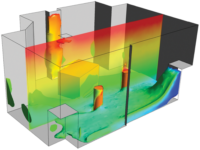It’s true, there’s a certain dramatic component to going to the hospital to get what is very possibly excellent treatment for one thing, but picking up another problem while you’re there. Yet, ask any group of patients what they want from their hospital experience, and irony and death remain way down on the list. That’s why we devote a few more pages in this month’s health care issue to the hospital-acquired infection (HAI) problem in the United States.
Addressing the problem on a much larger scale, just last month the CDC announced funding for six new Prevention Epicenters. The $11 million will support six academic institutions alongside the five others already working under this designation. The new additions are:
• Emory University
• The Johns Hopkins University
• University of Illinois, Chicago
• University of Iowa
• University of Maryland, Baltimore
• University of Utah
The specific assignment attached to the funding is to “identify possible new and improved ways to prevent the spread of infectious diseases” in health care facilities. Not surprisingly, Ebola is mentioned as one we’d really, really like to be ready for should it make another entrance into some random hospital’s ER. But while that disease grabs headlines and looms in our collective psyche, the damage continues to be done in real facilities across the country, in an everyday way that does not even make the local news.
The consequences of HAIs are real, even on a less important and strictly economic scale: while $11 million sounds like a fairly hefty sum, the CDC estimates that the problem adds billions of dollars to health care costs.
HVAC represents just one front in the effort to turn this trend around, but it’s a meaningful one. We’ll continue to address the topic, keeping an eye on both progress in research and developments in mechanical design and facility O&M. For a broader write-up on the epicenter project and their progress, you can visit www.cdc.gov/hai/epicenters.
Laboratory Conditions
I can’t let this month go by without a quick mention of a news story from my neck of the woods. You may have seen that when the project team was working on renovations for the University of Virginia’s well-known Rotunda, they came upon something unexpected: the remnants of a chemical hearth that is part of a very old science classroom.
How old? According to the University’s press release written by Matt Kelly, it was equipped by the school’s first professor of natural history, John Emmet, and founder Thomas Jefferson. In case you were wondering how a hands-on chemistry classroom might have been configured in the 1820s, it’s described thus:
The chemical hearth was built as a semi-circular niche in the north end of the Lower East Oval Room. Two fireboxes provided heat (one burning wood for fuel, the other burning coal), underground brick tunnels fed fresh air to fireboxes and workstations, and flues carried away the fumes and smoke. Students worked at five workstations cut into the stone countertops.
No hints at what the minimum ventilation rate might have been for those workstations. Still, I liked the reminder (similar to Kevin Dickens’ feature this month remembering former ASHRAE president Bill Coad) that we are always building on the progress of those who came before. That’s true even when we might temporarily lose track of what came before — or, very occasionally, plaster over it. ES








